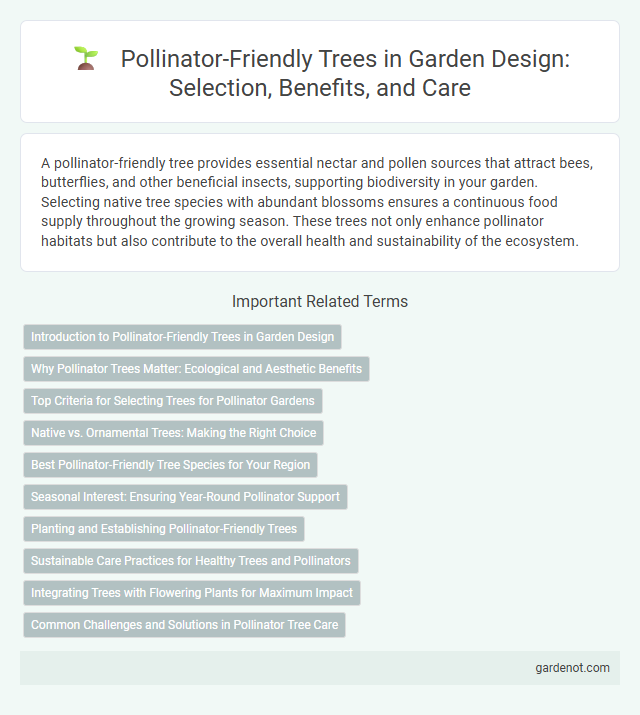A pollinator-friendly tree provides essential nectar and pollen sources that attract bees, butterflies, and other beneficial insects, supporting biodiversity in your garden. Selecting native tree species with abundant blossoms ensures a continuous food supply throughout the growing season. These trees not only enhance pollinator habitats but also contribute to the overall health and sustainability of the ecosystem.
Introduction to Pollinator-Friendly Trees in Garden Design
Pollinator-friendly trees play a crucial role in supporting biodiversity by providing essential nectar, pollen, and habitat for bees, butterflies, and other pollinators in garden ecosystems. Species such as flowering dogwood, black locust, and crabapple are favored for their abundant blooms and extended flowering periods, attracting a diverse range of pollinating insects. Incorporating these trees into garden design enhances ecological balance, promotes pollination of surrounding plants, and supports local wildlife populations.
Why Pollinator Trees Matter: Ecological and Aesthetic Benefits
Pollinator-friendly trees provide essential habitats and food sources for bees, butterflies, and other pollinators, promoting biodiversity and supporting ecosystem health. Their vibrant blossoms attract pollinators, enhancing local flora reproduction and contributing to sustainable agriculture. Beyond ecological importance, these trees offer aesthetic appeal through colorful flowers and seasonal changes, enriching garden landscapes while fostering environmental stewardship.
Top Criteria for Selecting Trees for Pollinator Gardens
Selecting pollinator-friendly trees for gardens requires prioritizing native species that provide abundant nectar and pollen to attract bees, butterflies, and hummingbirds. Trees with staggered bloom periods ensure continuous food sources throughout the growing season, supporting diverse pollinator populations. Additionally, choosing disease-resistant varieties helps maintain healthy ecosystems and reduce chemical intervention in pollinator habitats.
Native vs. Ornamental Trees: Making the Right Choice
Native trees such as oak, maple, and dogwood provide essential nectar, pollen, and habitat for local pollinators, supporting biodiversity and ecosystem health. Ornamental trees often lack the floral resources and ecological partnerships necessary for native pollinator species, potentially disrupting local pollination networks. Selecting native trees enhances pollinator-friendly gardens by promoting natural plant-pollinator interactions and sustaining native insect populations crucial for plant reproduction.
Best Pollinator-Friendly Tree Species for Your Region
Selecting the best pollinator-friendly tree species for your region enhances local biodiversity by providing essential habitats for bees, butterflies, and birds. Native trees such as oak, willow, and maple support a wide range of pollinators by offering nectar, pollen, and shelter throughout different seasons. Incorporating region-specific species like the Eastern Redbud in the Midwest or the Manzanita in the Southwest ensures optimal support for native pollinator populations and ecosystem health.
Seasonal Interest: Ensuring Year-Round Pollinator Support
Pollinator-friendly trees such as Serviceberry, Redbud, and Eastern Red Cedar provide seasonal interest by blooming at different times throughout the year, ensuring continuous nectar and pollen sources for pollinators. These trees support diverse pollinator species by offering flowers in spring, fruits in summer, and shelter in winter, creating a vital habitat year-round. Integrating a variety of these trees in pollinator gardens enhances ecological resilience and sustains pollinator populations across changing seasons.
Planting and Establishing Pollinator-Friendly Trees
Planting pollinator-friendly trees involves selecting native species such as redbud, serviceberry, and eastern red cedar, which provide essential nectar, pollen, and habitat for bees, butterflies, and birds. Establishing these trees requires attention to soil quality, proper spacing, and watering practices to promote strong root development and maximize floral output. Incorporating diverse tree species with staggered bloom times enhances continuous pollinator support throughout the growing season.
Sustainable Care Practices for Healthy Trees and Pollinators
Planting pollinator-friendly trees such as serviceberry, redbud, and willow enhances biodiversity and supports local pollinator populations by providing essential nectar and pollen resources. Sustainable care practices include mulching to retain soil moisture, avoiding chemical pesticides to protect vulnerable pollinators, and implementing proper pruning techniques to maintain tree health and maximize flowering potential. Regularly monitoring tree health and supporting native plant diversity in the garden contribute to a resilient ecosystem that sustains both healthy trees and thriving pollinator communities.
Integrating Trees with Flowering Plants for Maximum Impact
Integrating pollinator-friendly trees such as oak, maple, and linden with flowering plants like milkweed, coneflowers, and goldenrod creates a biodiverse habitat that supports bees, butterflies, and hummingbirds. Trees offer essential shelter and nesting sites while flowering plants provide abundant nectar and pollen throughout the growing season. This synergistic planting strategy enhances pollination efficiency, promotes ecosystem resilience, and supports local wildlife populations in a sustainable pollinator garden.
Common Challenges and Solutions in Pollinator Tree Care
Pollinator-friendly trees often face challenges such as pest infestations, nutrient deficiencies, and insufficient water supply that hinder their growth and flower production. Effective solutions include regular monitoring for pests, applying organic fertilizers rich in phosphorus and potassium to promote blooming, and implementing mulching techniques to retain soil moisture. Selecting native tree species adapted to local climate conditions also enhances resilience against environmental stressors and supports diverse pollinator populations.
Pollinator-friendly tree Infographic

 gardenot.com
gardenot.com